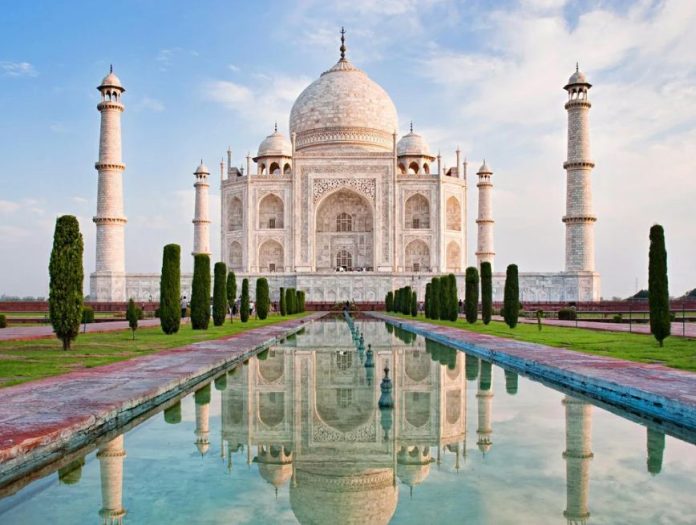By Journey Man
The city of Agra holds an indelible mark in the history of India. Home to one of the Seven Wonders of the World, the Taj Mahal, Agra is also known for other architectural wonders from the Mughal era. Each famous site, whether a monument, shrine or tomb, depicts a story of its own. Known for its intricate carved handicraft work, rambling landscaped gardens, and scrumptious food, there is a lot that makes Agra one of India’s most preferred tourist destinations.
Wander around its ancient lanes and you would know what makes it such a hit. It is 378 km west of the state capital, Lucknow, 206 km south of the national capital New Delhi, 50 km south from Mathura and 115 km north of Gwalior. Agra is one of the most populous cities in Uttar Pradesh, and the 24th most populous city in India.
Though the wonderful allure of the Taj Mahal attracts people from around the world over to Agra, it is not a standalone attraction. The city offers a trail of fascinating tombs and mausoleums to explore. Acclaimed for its lavish crafts like Pietra Dura (marble inlay) work, rugs and leather goods, and the luscious petha, Agra equally caters well to shopaholics and foodies.
History
It is generally accepted that Agra was both an ancient city from the times of the Mahabharata and yet Sultan Sikandar Lodī, the Muslim ruler of the Delhi Sultanate, founded Agra in the year 1504.
There are many stories and legends about the ancient city of Agra. According to Indian mythology, Agra fort is said to have been a state prison in the time of Raja Kansa (uncle of Lord Krishna), ruler of Mathura.
Sikandar Lodi captured Agra along with Bayana (in Uttar Pradesh) in 1491-92. Agra was then a dependency of the pargana of Bayana and it was captured from Habibat Khan Jalwani, a vassal of Sultan Ashraf, also known as Sharf-ud-din Jalwani of Bayana. In 1505, he transferred the capital to Agra.
After the Sultan’s death, the city passed on to his son, Sultan Ibrāhīm Lodī. He ruled his Sultanate from Agra until he fell fighting to Mughal Badshah (emperor) Bābar in the first battle of Panipat fought in 1526.
The golden age of the city began with the Mughals. It was then known as Akbarabād and remained the capital of the Mughal empire under the Badshahs (emperors) Akbar, Jahāngīr and Shāh Jahān. Akbar made it the eponymous seat of one of his original twelve subahs (imperial top-level provinces), bordering (Old) Delhi, Awadh (Oudh), Allahabad, Malwa and Ajmer subahs. Shāh Jahān later shifted his capital to Shāhjahānabād in the year 1649.
Since Akbarabād was one of the most important cities in India under the Mughals, it witnessed a lot of building activity. Babar, the founder of the Mughal dynasty, laid out the first formal Persian garden on the banks of river Yamuna. The garden is called the Arām Bāgh or the Garden of Relaxation. His grandson Akbar the Great raised the towering ramparts of the Great Red Fort, besides making Agra a centre for learning, arts, commerce and religion. Akbar also built a new city on the outskirts of Akbarabād called Fatehpūr Sikrī. This city was built in the form of a Mughal military camp in stone.
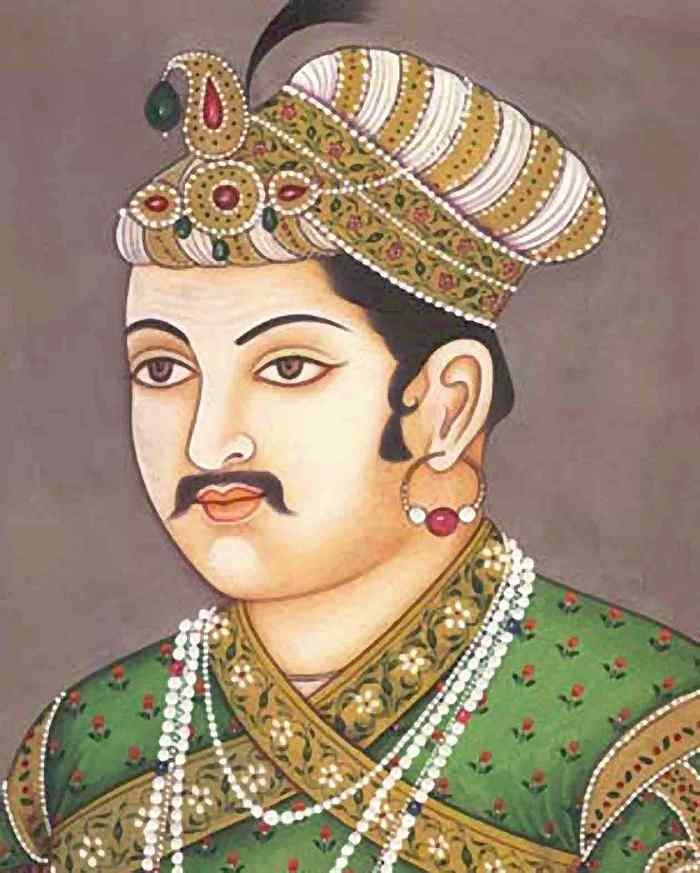

His son Jahāngīr had a love of flora and fauna and laid many gardens inside the Red Fort or Lāl Qil’a. Shāh Jahān, known for his keen interest in architecture, gave Akbarabād its most prized monument, the Tāj Mahal. Built in loving memory of his wife Mumtāz Mahal, the mausoleum was completed in 1653.
Shāh Jahān later shifted the capital to Delhi during his reign, but his son Aurangzeb moved the capital back to Akbarabād, usurping his father and imprisoning him in the Fort there. Akbarabād remained the capital of India during the rule of Aurangzeb until he shifted it to Aurangabad in the Deccan in 1653.
After the decline of the Mughal Empire, the city came under the influence of Marathas and was called Agra, before falling into the hands of the British Raj in 1803.
In 1835 when the Presidency of Agra was established by the British, the city became the seat of government, and just two years later it was witness to the Agra famine of 1837–38. During the Indian rebellion of 1857 British rule across India was threatened, news of the rebellion had reached Agra on 11 May and on 30 May two companies of native infantry, the 44th and 67th regiments, rebelled and marched to Delhi. The next morning native Indian troops in Agra were forced to disarm, on 15 June Gwalior (which lies south of Agra) rebelled. By 3 July, the British were forced to withdraw into the fort. Two days later a small British force at Sucheta were defeated and forced to withdraw, this led to a mob sacking the city. However, the rebels moved onto Delhi which allowed the British to restore order by 8 July. Delhi fell to the British in September, the following month rebels who had fled Delhi along with rebels from Central India marched on Agra but were defeated. After this British rule was again secured over the city until the independence of India in 1947.
Agra is the birthplace of the religion known as Dīn-i Ilāhī, which flourished during the reign of Akbar and also of the Radhaswami Faith, which has around two million followers worldwide. Agra has historic linkages with Shauripur of Jainism and Runukta of Hinduism, of 1000 BC.
Origin and Development
Agra is the city of the inimitable Taj Mahal. The story of Agra begins much earlier than the Taj, However it finds mention in the epic Mahabharata when it was called Agrabana are Paradise. Ptolemy, the famous second century CE geographer, marked it on his map of the world as Agra. Tradition and legend ascribe the present city of Raja Badal Singh (around 1475 CE) whose fort Badalgarh stood on or near the site of the present fort.
However, the 12th century CE Persian poet Salman, too, speaks of a desperate assault on the fortress of Agra, then held by one King Jaipal, by sultan Mahmud of Ghazni. It was the Mughals who finally nurtured Agra with the finest monuments architects could design: The Taj Mahal of Shah Jhan, Agra Fort of Akbar, Itmad-Ud-Daulah and neighbouring Sikandra are but few of the many that spangle the city, each of which stands in mute testimony to the city’s grandeur over the ages.
Geographical condition
The Agra district is situated in western UP, between 27.11′ degree Latitude North and 78.0′ degree to 78.2′ degree Longitude East. Its altitude is 169 meters above sea level. On the north it is bounded by Mathura district, on the south it is bounded by Dhaulpur district, on the east it is bounded by Firozabad district and on the west it is bounded by Bharatpur. Agra is situated on the bank of Yamuna river.
In Agra Maximum Temperature in Summer is 45 degrees Celsius and minimum temperature is about 21.9 degrees C. In winter the maximum temperature is around 13.7 degrees, while the minimum temperature is about 4.2 degrees. Best season for tourists is from October to March.
How to Reach
By Air: Agra’s Kheria airport is also a military base. It is a seasonal commercial airport and is connected only by Air India flights from New Delhi. The flight from Delhi to Agra is less than an hour long. Kheria airport is 13 kilometres away from Agra city.
By Bus: Agra is well connected by bus to cities like Delhi, Jaipur, Gwalior, Lucknow and Kanpur. Daily buses ply between these cities.
From New Delhi bus to Agra takes 3h 30m. Agra has two major interstate bus terminals called Idgah Bus Stand (which is located right in the centre of the city and is 8 kilometres from the Taj Mahal) and ISBT (which is located at a distance of 12 kilometres from the Taj Mahal).
By Train: Agra is situated on the Delhi-Mumbai and Delhi-Chennai route and is well connected to most cities across India.
The cheapest way to reach from New Delhi to Agra is train to Agra Cantt and takes 2h 15m.
There are regular trains to Agra from cities like Delhi, Jaipur, Gwalior and Jhansi. Agra is also well connected to cities in other parts of the country such as Kolkata, Mumbai and Chennai. There are five railway stations in Agra – Agra Cantt Station (the main station), Agra Fort Railway Station, Raja ki Mandi, Agra City and Idgah Railway Station.
Road/Self Drive: Agra is connected to Delhi by NH2 and the new Yamuna Expressway. The drive time is about 2-3 hours depending on traffic and time of the day. Jaipur is connected to Agra by NH11 and is a 4-5 hour drive. Gwalior, connected by NH3 is a 1.5-hour drive while Lucknow and Kanpur, connected by Agra-Lucknow Expressway/NH2, are about a 4-hour and 5-hour drive, respectively.
PLACES TO SEE
Taj Mahal
The Taj Mahal is located on the right bank of the Yamuna river in a vast Mughal garden that encompasses nearly 17 hectares.
The Taj Mahal of Agra is one of the Seven Wonders of the World, for reasons more than just looking magnificent. It’s the history of Taj Mahal that adds a soul to its magnificence: a soul that is filled with love, loss, remorse, and love again. Because if it was not for love, the world would have been robbed of a fine example upon which people base their relationships. An example of how deeply a man loved his wife, that even after she remained but a memory, he made sure that this memory would never fade away.
This man was the Mughal Emperor Shah Jahan, who was deeply in love with Mumtaz Mahal, his dear wife. She was a Muslim Persian princess (her name Arjumand Banu Begum before marriage) and he was the son of the Mughal Emperor Jehangir and grandson of Akbar the Great. It was at the age of 14 that he met Mumtaz and fell in love with her. Five years later in the year 1612, they got married.
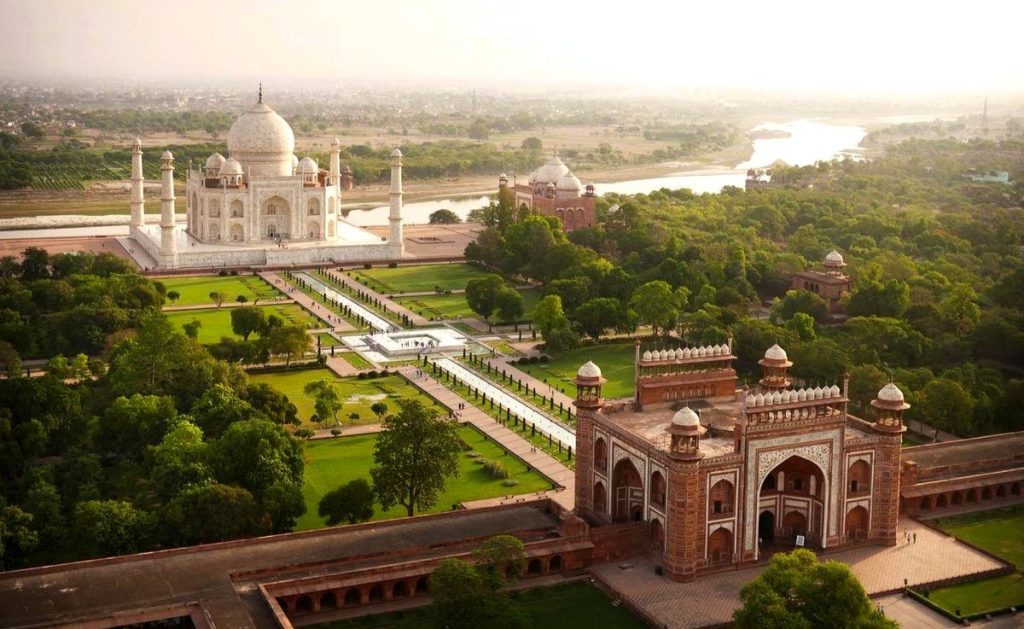

The Taj Mahal is considered to be the greatest architectural achievement in the whole range of Indo-Islamic architecture. Its recognised architectural beauty has a rhythmic combination of solids and voids, concave and convex and light shadow; such as arches and domes further increases the aesthetic aspect. The colour combination of lush green scape reddish pathway and blue sky over it showcases the monument in ever changing tints and moods. The relief work in marble and inlay with precious and semi precious stones make it a monument apart.
Mumtaz Mahal, an inseparable companion of Shah Jahan, died in 1631, while giving birth to their 14th child. It was in the memory of his beloved wife that Shah Jahan built a magnificent monument as a tribute to her, which we today know as the Taj Mahal.
The construction of Taj Mahal started in the year 1631. Masons, stonecutters, inlayers, carvers, painters, calligraphers, dome-builders and other artisans were requisitioned from the whole of the empire and also from Central Asia and Iran, and it took approximately 22 years to build what we see today. An epitome of love, it made use of the services of 22,000 labourers and 1,000 elephants. The monument was built entirely out of white marble, which was brought in from all over India and central Asia. After an expenditure of approximately 32 million rupees, Taj Mahal was finally completed in the year 1653.
It was soon after the completion of Taj Mahal that Shah Jahan was deposed by his own son Aurangzeb and was put under house arrest at nearby Agra Fort. Shah Jahan, himself also, lies entombed in this mausoleum along with his wife. Moving further down the history, it was at the end of the 19th century that British Viceroy Lord Curzon ordered a sweeping restoration project, which was completed in 1908, as a measure to restore what was lost during the Indian rebellion of 1857: Taj being blemished by British soldiers and government officials who also deprived the monument of its immaculate beauty by chiselling out precious stones and lapis lazuli from its walls. Also, the British style lawns that we see today adding on to the beauty of Taj were remodelled around the same time. Despite prevailing controversies, past and present threats from the Indo-Pak war and environmental pollution, this epitome of love continues to shine and attract people from all over the world.
Timings of Taj Mahal
The compound is open for a time period of thirteen hours, from 6:00 in the morning till 7:00 in the evening on weekdays except for the Fridays. On Fridays, the complex is open only for 2 hours, from 12 PM to 2 PM in the afternoons for prayers at the mosque. The compound is also open for night viewing during the full moon, on that day and two days before and after. This program excludes the month of Ramadan and the Fridays.
Entrance Fees of Taj Mahal
- Indian – Rs 50
- SAARC and BIMSTEC – Rs 535
- Foreigner – Rs 1050
- Children Below Age 15 – Free
Agra Fort
A massive red-sandstone fort located on the banks of River Yamuna was built under the commission of Emperor Akbar in 1565 and was further built by his grandson Shah Jahan. The fort, semi-circular on plan, is surrounded by a 21.4 m high fortification wall. The fort was built primarily as a military structure; parts of it are still reserved under the Indian Army.
Shah Jahan transformed it into a palace, later it became his gilded prison for eight years after his son Aurangzeb seized power in 1658. The fort houses a maze of buildings, including vast underground sections. The Amar Singh Gate to the south is the sole entry point. A path leads straight from here up to the large Moti Masjid. Just before this was the open Diwan-e-Aam, where Shah Jahan listened to people’s petitions or issues.
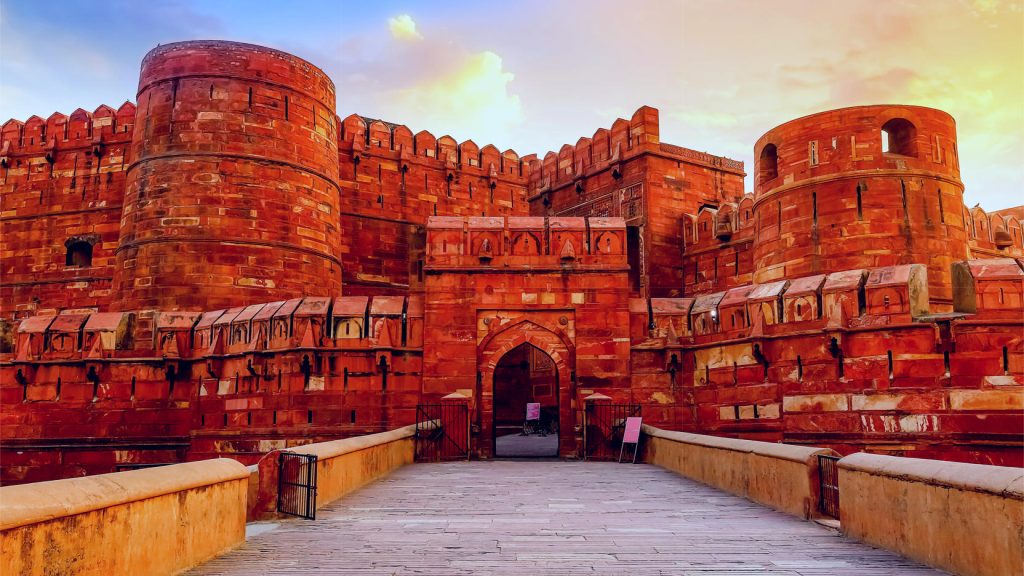

A small staircase just to the left of Diwan-e-Aam throne leads up to a large courtyard. To the left is a beautiful white marble Nagina Masjid. Other places to see within the Fort are: Diwan-e-Khas – which once housed Shah Jahan’s legendary Peacock throne and the diamond Koh-I-Noor, Shish Mahal- a palace with walls inlaid with tiny mirrors, and Khas Mahal – the white octagonal tower and palace. In the South of the fort, there is a huge red-sandstone Jahangir’s Palace, built by Akbar probably for his son Jahangir.
Tomb of Akbar
The tomb of Akbar the Great, located in Sikandra, in the suburbs of Agra is an important Mughal architectural masterpiece, which was built between 1605-1613. Akbar himself commenced the construction of this tomb, according to Tartary tradition, which stated to commence the construction of one’s tomb during one’s lifetime. The South gate of this tomb is the largest with four white marble chhatri-topped minarets, similar to those of the Taj Mahal. The buildings are constructed mainly from deep red sandstone. An inscription on the mausoleum reads: ‘These are the Gardens of Eden: enter them to dwell eternally.’
Itmad-Ud-Daula
A masterpiece of design and construction, this tomb was built under the commission of Empress Noor Jahan in memory of her father Mirza Ghias Beg in 1623-28 CE. This ornate tomb is considered a precursor of the Taj Mahal. It is built completely in white marble and reflects a dazzling charm to the visitors.
Guru Ka Taal
Guru Ka Taal is a very famous Gurudwara in Agra. The construction of this place was started in the 1970’s and it is said that four out of the 10 Sikh gurus are said to have paid it a visit. This Gurudwara has both historical and religious importance, and attracts a large number of devotees and tourists. Every year thousands of devotees gather here to pay homage to the great Sikh guru. This beautiful structure is reckoned among the magnificent architectural wonders of India. Boasting elaborate stone carvings this Gurudwara beckons travellers from far and away to bask in its glory.
Mankameshwar Mandir
One of the ancient Shiva temples in the country, Mankameshwar Mandir holds much religious importance as according to the legend, Shiva installed a lingam here on his own. The Mughal architecture isn’t the only thing that draws tourists to Agra, temples like these are also crowd-pullers. The temple is close to Agra Fort and near other tourist monuments like the Taj Mahal. As per the legend, Shiva wanted to go to Mathura after the birth of Krishna to get a glimpse of the little baby boy. During his descent from Mount Kailash, he rested and meditated at the sight of this temple and declared that if he is able to reach in time to see Krishna, he will install his swaroop here. And so, on his way back he kept his word and there was a lingam here covered in silver.
Nearby Tourist Place
Fatehpur Sikri
Perched atop a rocky ridge, 35 KM west of Agra, Fatehpur Sikri came into being centuries ago as a city of victory for Emperor Akbar. The city’s red sandstone architecture and intricate carvings give a dreamy experience.
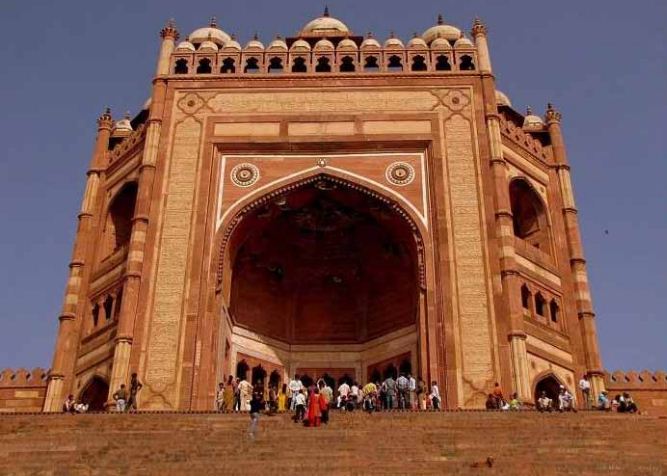

Mathura
Located at a distance of 49 KM from Agra, Mathura is the birthplace of Lord Krishna. Dotted with magnificent temples depicting the various phases of Lord Krishna’s life it takes the devotees back to the divine era.
Sur Sarovar Bird Sanctuary
Escape the hullaballoo of the city with this beautiful place tucked away 26 Kms outside the city of Agra. Winter time is best to catch a sight of the beautiful migratory birds here.
India’s largest footwear manufacturing hub
Agra is renowned all over the world not only for Taj Mahal’s beauty but also for the production of footwear. It is considered a very large footwear manufacturing centre, not only in India but probably in the world. In fact it is the largest footwear market in Asia. Visiting India provides countless travel options, along with its rich history and culture to make it easy, you need a fixer in India to provide all media support for filming in India.
The footwear industry in Agra has an old link with the Mughal era. In India the first footwear was created in Agra. Agra’s leather footwear is known around the world for excellent craftsmanship. Fully handmade shoes are distinguished from class.
Employment
Agra footwear market provides a lot of choice for customers. Agra is home to 5,000 footwear stores. Nearly 60 percent of the population relies on footwear trade, primarily in hand-made cottage footwear.
The sector hires approximately 2 million workers directly and similarly in indirect jobs, about 75,000 of whom are working in listed firms, while about 1,25,000 are working in unregistered units.
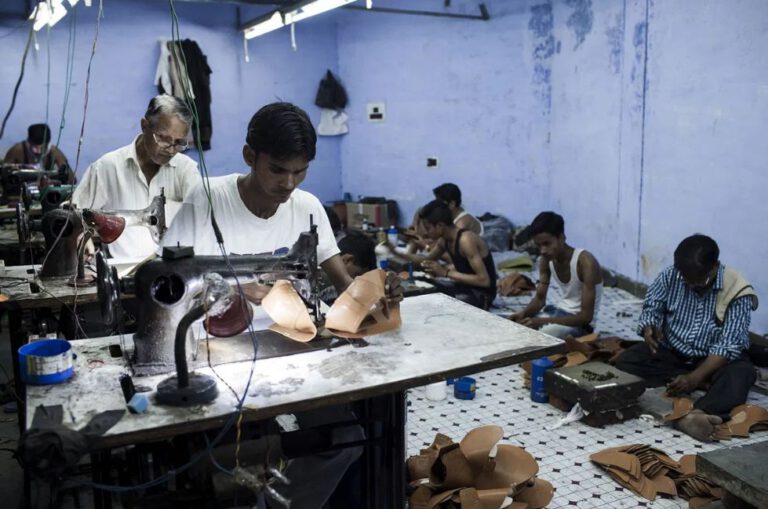

Leather Industry occupies a position in the Indian economy because of its important contribution to employment generation and export-oriented growth initiatives in our countries. Today this sector is the nation’s sixth highest foreign exchange earner and accounts for about 4-5 percent of our overall exports. Footwear industry is one of the main leather industry segments, currently spread throughout the world.
The pattern of the footwear industry in town is that of a mixture of small-scale units and large-scale units that use mechanical equipment to manufacture footwear. Moreover, Agra’s footwear industry includes cottage units, medium units, and registered companies.
Where to stay
Oberoi Amar Vilas: Starting price @Rs 8550/
This multi award-winning resort is simply impossible to fault. Facing the tranquil access road to India’s magnificent monument of love, the Oberoi is majestic, sumptuous, and exudes an adorable colonial-era vibe. Designed like a Mughal palace among flourishing gardens and immaculate lawns rarely seen anywhere in India, the setting is mesmerizing. This is especially so around the sparkling blue pool flanked by terraces, gardens, and courtyards. All suites are as luxurious and elegant as expected, and amazingly, all of them boast views of the Taj Mahal.
About 650m from the ticket office at the East Gate of the Taj Mahal.
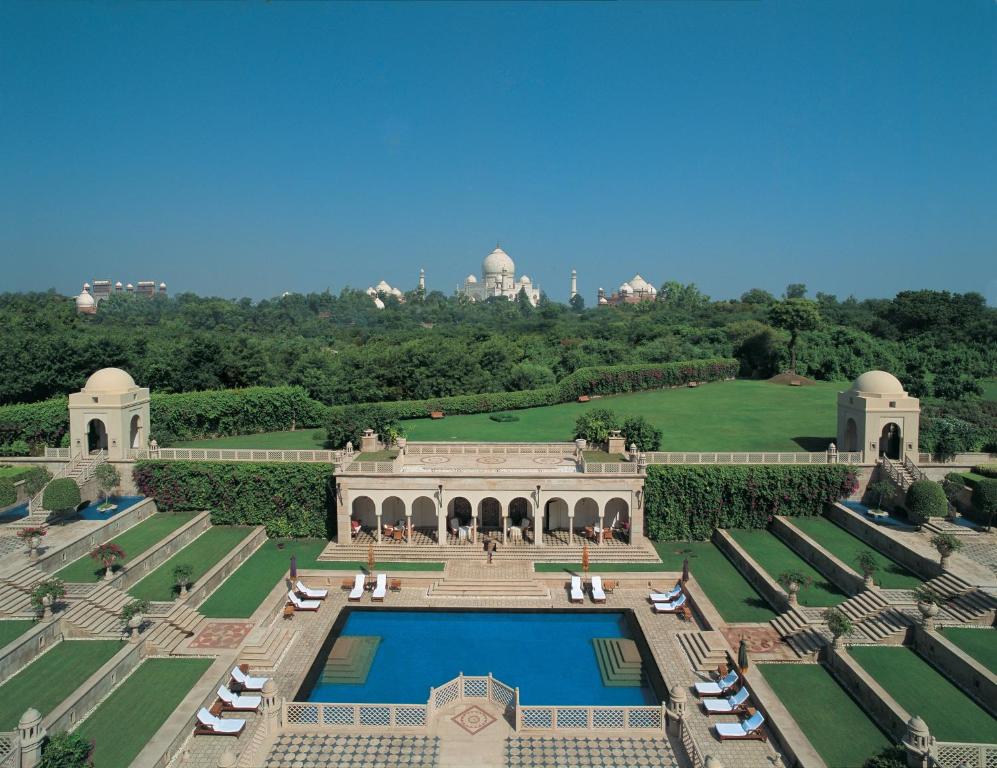

About 7 km from the Agra Cantonment Railway Station, which has most services to/from Delhi and Jaipur, and about 15 km from the new airport. Both are accessible by taxi or auto-rickshaw.
ITC Mughal:Starting price @Rs 7250/
It exudes an old-fashioned grace with endless reminders of the Mughal Empire, and is packed with facilities rarely found elsewhere, such as landscaped gardens and a resort-style pool. Catering very well for families – also a rarity – the ITC offers a tennis/basketball court, playground, and maze of hedges. Marble floor bridges with names link the lobby with the rooms – which are all suitably stylish and spacious and suites, which also feature Turkish-style ground-level sofas.
Hotel Marygold; starting price@1599
Agra Hotels Marygold is set in Agra, within 2.5 km of Taj Mahal and 7.9 km of Agra Cantonment. Among the facilities of this property are a restaurant, a 24-hour front desk and room service, along with free WiFi.

